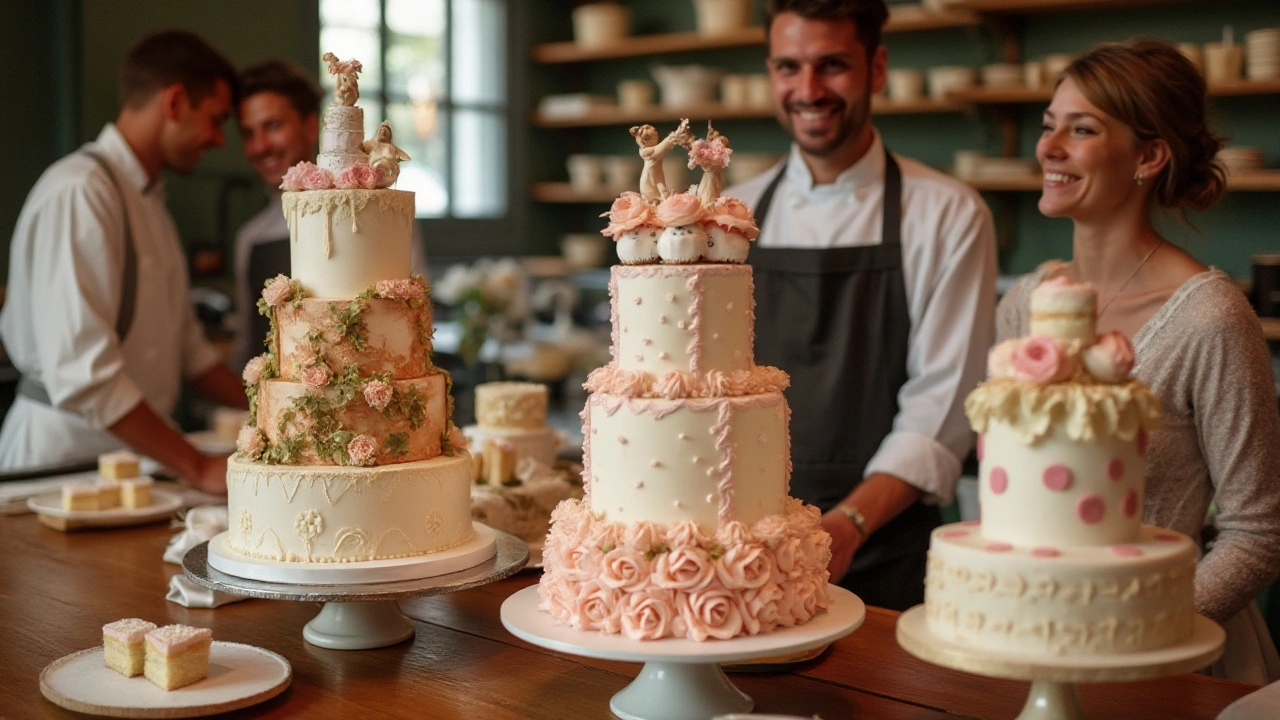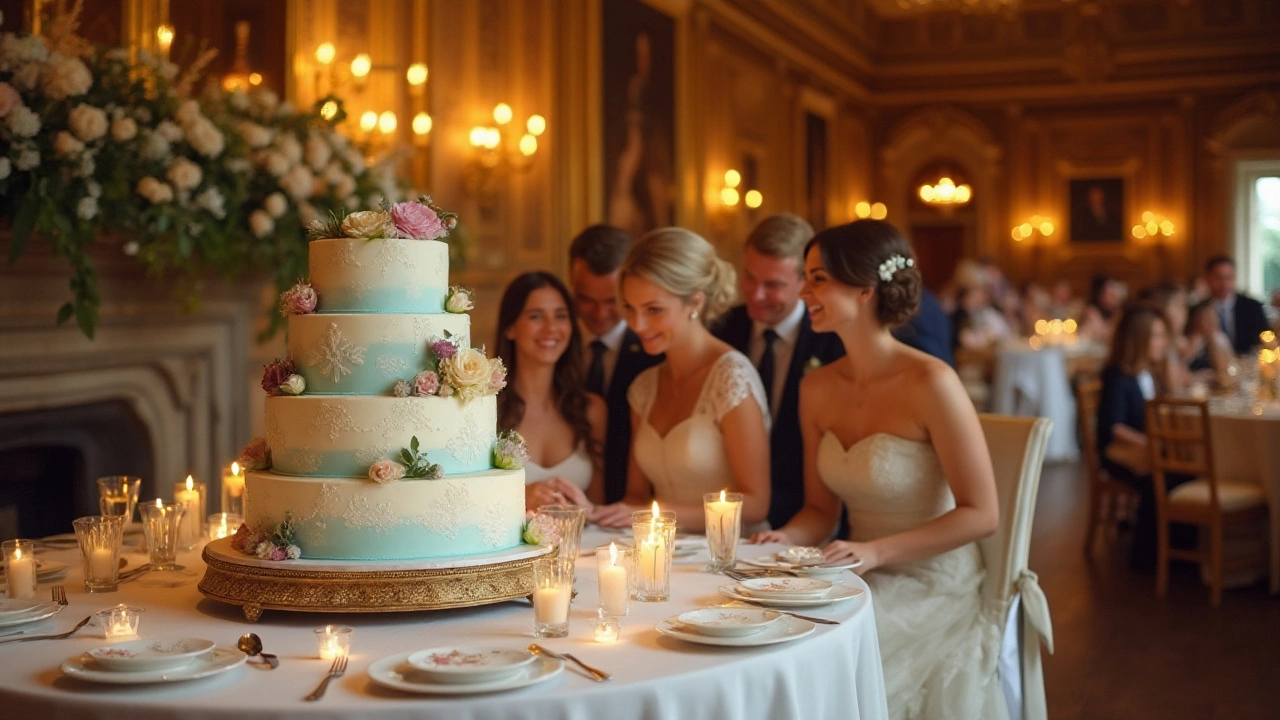Creating the perfect wedding experience involves a multitude of details, and one sweet detail stands as a centerpiece: the cake. With 100 guests expected at your celebration, it's important to balance aesthetics and practicality when choosing the cake size. From portion sizes to design, every aspect plays a part in making your big day a memorable one.
Understanding the science of cake portions is a great start to ensuring satisfaction. Serving the right amount without wastage is key. Not everyone will opt for a traditional slice, so tailoring your cake choices to accommodate dietary restrictions and preferences helps in achieving that perfect balance. Navigating these choices with a creative mindset can turn this task into an exciting endeavor.
- Understanding Cake Portions
- Types of Wedding Cakes
- Customizing for Preferences
- Practical Tips and Tricks
Understanding Cake Portions
Delving into the intricacies of cake portions can be a delightful revelation as you plan for your wedding day. It's not just about selecting a sweet confection that looks stunning; it's also understanding how it serves your guests. A standard wedding cake slice is thinner than what you might serve at a birthday party, measuring approximately one inch by two inches in width and height. This guide helps ensure every guest gets a fair share without leaving anyone wanting or leading to a pile of leftovers they wanted no part of. While indulging your curiosity for cake sizes, it’s fascinating to note how these portions cater not only to quantity but also to tastes and preferences.
Traditionally, a three-tier cake serves about 50 to 100 guests, depending on the tier sizes. The bottom tier typically yields the most servings, catering to around half of your expected guest count. As you move upwards, portions naturally decrease, yet each tier plays a crucial role in the cake's visual impact. It's a good idea to mix and match flavors across the tiers, allowing guests with varying palates to find something they're fond of. A statistic worth considering comes from the National Wedding Council, stating that nearly 60% of couples choose vanilla as a safe and universally loved flavor alongside daring options like red velvet or exotic passionfruit.
For those interested in precision and avoiding waste, consider hiring a seasoned cake specialist who could guide you through the numbers. They often use serving charts as a reference, adjusting the cake size based on the guest turnout and time of day your reception is held. Did you know that evening weddings tend to have higher cake consumption as opposed to their lunchtime counterparts? This surprising insight highlights the importance of knowing your audience. The careful calculation of servings could save your budget from unnecessary expenditure while ensuring each participant has their sweet craving satisfied.
Equally important in deciding cake portions is the element of dietary considerations among attendees. With the rise in gluten-free, vegan, and allergen-conscious diets, offering an additional small cake or individual cupcakes that cater to these needs can be a true gift to your guests, showing empathy and ensuring no one feels left out. Even these auxiliary options should follow portion guidelines to maintain consistency with your main cake's service. As John Smith, an esteemed wedding planner, once remarked,
"A perfect wedding is not just about aesthetics, but how your heart touches every guest through even the smallest of details."Keeping this quote in mind can help steer your decisions further as you craft a day filled with joy and sweet satisfaction.

Types of Wedding Cakes
When it comes to picking the perfect cake for your wedding, there's a delightful range of wedding cake types to consider. Traditional to modern interpretations, each reflects not only style but adds flavor to your reception in every sense. Classic tiered cakes remain favorites due to their stunning visual presence and versatility, elegant with layers stacked high, usually graced with fondant or buttercream. These cakes can range from smooth surfaces decorated with intricate piping to more avant-garde designs involving geometric patterns, textures, and even watercolors.
Cake portions play an important role, as does the flavor. Classic flavors like vanilla and chocolate are timeless, yet couples are veering towards adventurous options such as salted caramel or raspberry champagne. Consider shaped cakes, too! They're crafted to reflect themes or even mimic textures, such as rustic "naked cakes" that show off layers with minimal frosting. These choices offer ease to those who prefer a less conventional route, ensuring a personal touch to the cake—highlighting creativity alongside delectable taste.
"Let the cake whisper sweet stories of who you are and what you love," says renowned wedding planner Sarah Haywood.
Don't forget the cutting cake for couple photo ops. Opting for a lavishly decorated one you might not serve, can offer that picture-perfect moment without needless extra servings. Timeline and budget often dictate whether you go for a single masterpiece or multiple smaller cakes. Store-bought sheet cakes, perhaps hidden in the back, provide extras without breaking the bank—an ideal compromise.
Other popular options include fresh floral decorations or hand-painted designs that suit wedding planning themes. For the eco-conscious, some decorators use organic ingredients, locally sourced where possible. Vegan or gluten-free offerings ensure all guests feel included too. Whatever option you choose, let it mirror your identity and journey together. Many stunning cakes remain etched in attendee's memories, not because they were extravagant, but because they resonated with the couple's story so poignantly.

Customizing for Preferences
When it comes to a wedding, personalization adds a touch of magic, and your wedding cake is no exception. With 100 guests, diversity in preferences is inevitable. Customizing your wedding cake to suit a variety of tastes not only enhances guest satisfaction but also makes your celebration uniquely yours. Start by considering the popular flavors. Traditional favorites include vanilla and chocolate, but modern palettes often lean into more contemporary choices like red velvet, lemon, or even exotic flavors such as passionfruit or pistachio.
Moreover, dietary restrictions have become increasingly common. Catering to these needs can include offering options such as gluten-free or vegan cakes. According to a 2023 survey from the National Wedding Association, nearly 40% of weddings now feature cakes that cater to specific dietary requirements. This statistic stands as a testament to the growing trend of inclusivity. Deciding on how to incorporate this into your wedding involves discussions with your chosen cake maker, who might have creative solutions like having a smaller tier reserved for those with specific needs.
Presentation matters too. With the advent of social media, the visual allure of a wedding cake often takes center stage. Think about colors and decorations that match your wedding theme. Edible flowers, metallic accents, or intricate sugar work can bring a level of sophistication and excitement. As famous wedding planner Sarah Haywood once said,
"A cake should do more than just satisfy the taste buds—it should also captivate the eyes."Emphasizing the cake's rolet as an artful centerpiece reinforces its importance beyond taste.
Moreover, think about the cutting ceremony itself. Some couples choose to enhance the moment by including cupcakes or mini desserts—an option offering guests variety while keeping a traditional cake for the ceremonial cut. The National Confectioners Association reported in 2023 that dessert tables with multiple dessert types are preferred by 65% of couples, showcasing the preference for variety. This approach allows guests to select according to their tastes and brings an enticing visual spread that is both inviting and interactive.
Finally, collaborate closely with your baker. Good communication ensures your vision is realized. Share mood boards, cake designs you love, and be open to their suggestions. A seasoned baker can guide you about portion sizes, structural possibilities, and how to best blend flavor profiles for optimal results. Their expertise can result in a beautifully balanced and memorable creation that resonates with every guest.

Practical Tips and Tricks
When it comes to feeding 100 guests at your wedding, finding the right balance between creativity, satisfaction, and economy is essential. The perfect wedding cake should not only taste good but should also be portioned correctly to ensure that none of the sweet treats go to waste. Start by collaborating with your chosen baker early. Together, you can decide on the ideal size and style for your cake, considering both your budget and the theme of your celebration. One helpful trick is to request a combination of different cake tiers and sheet cakes that can be sliced in the kitchen. This approach maintains the elegance of having a beautifully decorated main cake while ensuring there's enough to go around.
Consider guest preferences for flavors. Offering a diverse selection of cakes, such as chocolate, vanilla, or even red velvet, can cater to a variety of palates. Don’t forget the necessity of accommodating dietary needs, such as gluten-free or vegan options, which have become increasingly common. A good wedding cake maker will have a repertoire of recipes that cater to these needs without compromising on taste or quality. An interactive cake table, where guests can choose their slices, can turn the dessert moment into a delightful highlight of your reception, bringing an added layer of engagement and anticipation.
Timing is another key aspect to consider. Planning the cake-cutting ceremony during prime photographic moments ensures everyone has a chance to appreciate and admire your cake's artistry before it’s served. It’s also wise to have a designated cake “guardian”—someone who keeps an eye on the distribution. Serving evenly sized pieces prevents any awkwardness of running out before everyone’s been served. If you are uncertain, conducting a small tasting session beforehand offers assurance on your chosen flavors and presentation. As one popular saying goes, encapsulated in a
“You can’t make everyone happy. You’re not cake.”, yet when managed well, your cake can spread joy and gratify all 100 of your guests.
Beyond these tips, employing practical tools like a portion guide can alleviate some pressures. A common practice is utilizing a
| Guest Count | Number of Tiers | Cake Size |
|---|---|---|
| 50 | 2 tiers | 7" and 9" |
| 100 | 3 tiers | 6", 8", and 10" |
| 150 | 4 tiers | 6", 8", 10", and 12" |
